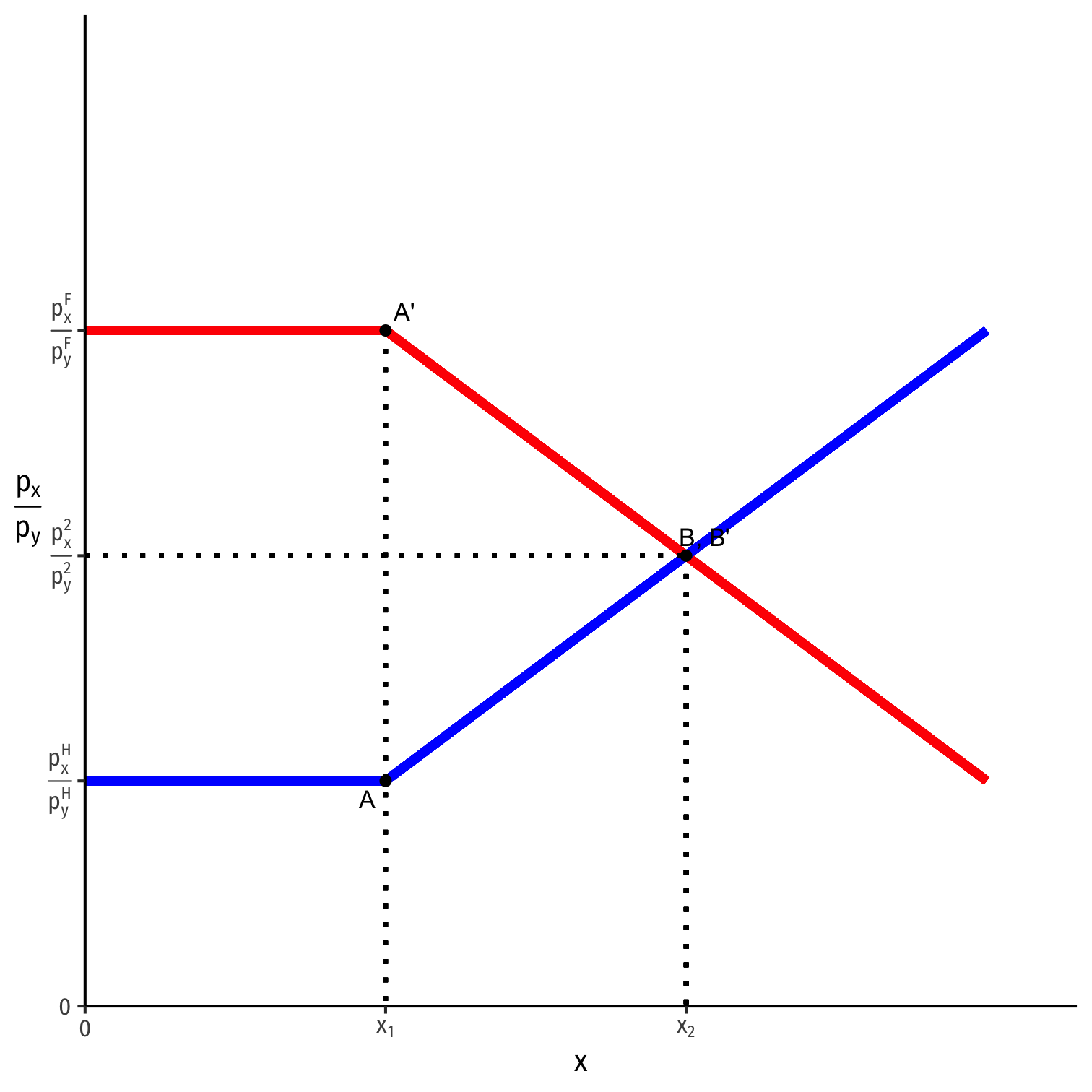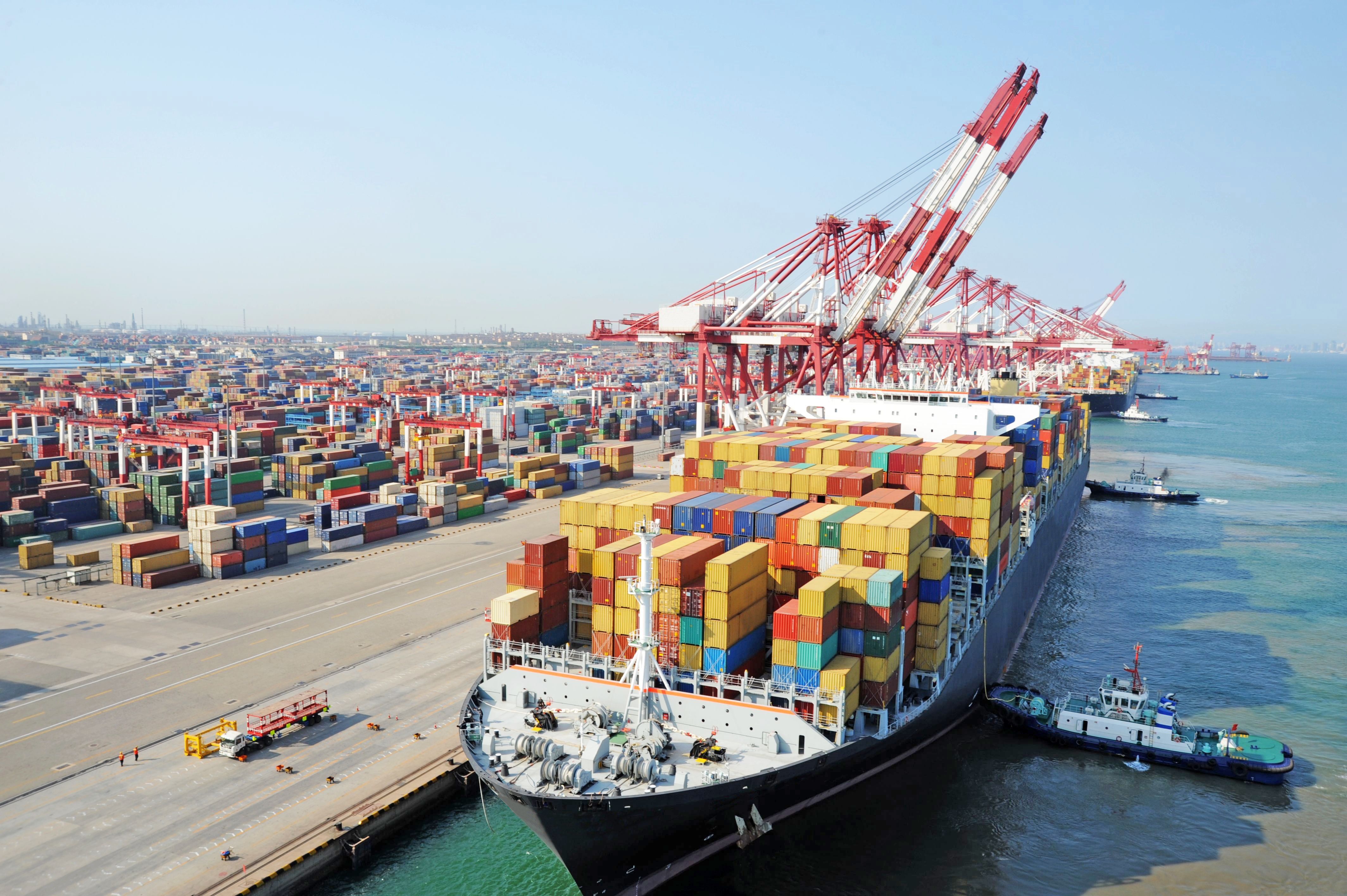1.7 — The Terms of Trade Changes
ECON 324 • International Trade • Spring 2023
Ryan Safner
Associate Professor of Economics
safner@hood.edu
ryansafner/tradeS23
tradeS23.classes.ryansafner.com
Quick Review of Standard Model
The Global Market for x
World equilibrium relative price of x: (pxpy)2 balances Home's exports and Foreign's imports of x
As countries trade, changes relative price of x in each country until both reach equilibrium world relative price (B,B'), where both countries have same relative price:
(pxpy)H<(pxpy)2<(pxpy)F

Autarky Equilibrium
Home

Foreign

- Countries begin in autarky optimum with different relative prices
- A is optimum for Home
- A' is optimum for Foreign
Specialization
Home

Foreign

International trade changes the relative price of x (↑ for Home, ↓ for Foreign)
With international trade, countries face same world relative prices (slope of dark purple dashed line)
Specialization
Home

Foreign

Countries specialize: produce more of comparative advantaged good, less of disadvantaged good
- Home: A → B: produces more x, less y
- Foreign: A' → B': produces less x, more y
Note this is incomplete specialization: countries still produce both goods!
Trade Triangles
Home

Foreign

- Home → x → Foreign
Trade Triangles
Home

Foreign

Home → x → Foreign
Home ← y ← Foreign
Gains from Trade
Home

Foreign

Both countries exchange their imports & exports and consume at C and C'
Both reach a higher indifference curve with trade, well beyond their PPFs!
Changes in the Terms of Trade
Some Trade-Related Issues
- Is economic growth in other countries good or bad for our country?
- Good: larger markets for our exports, lower prices for our imports
- Bad: increased competition for our exporters and for our domestic producers competing with imports

Some Trade-Related Issues
- Is economic growth in our country more or less valuable when we are part of a globalized world economy?
- Good: we can sell more to the world market
- Bad: the benefits of our growth don't stay at home, are dispersed to foreigners importing at cheaper prices

The Terms of Trade
Terms of trade are another name for the relative price of x or y in the international trade equilibrium
We express the terms of trade (TOT) for a country as the relative price of that country's exports:
- How many imports does a country gain per export
TOT=pexportspimports

The Terms of Trade
TOT=pexportspimports
In our examples:
- For Home (exporter of x): TOT=pxpy
- For Foreign (exporter of y): TOT=pypx
The terms of trade can change over time as countries' supply (of exports) and demand (for imports) changes

Changes in the Terms of Trade
Home

Foreign

Changes in the Terms of Trade
Home

Foreign

- Suppose equilibrium relative price of x decreases (relative price of y increases): slope gets flatter
Changes in the Terms of Trade
Home

Suppose equilibrium relative price of x decreases (relative price of y increases): slope gets flatter
Home (exporter of x, importer of y) reaches a lower indifference curve (at D) than before (at C)
Home's TOT: pxpy worsened (fewer imports per export)
Changes in the Terms of Trade
Suppose equilibrium relative price of x decreases (relative price of y increases): slope gets flatter
Foreign (exporter of y, importer of x) reaches a higher indifference curve (at D') than before (at C')
Foreign's TOT: pypx strengthened (more imports per export)
Foreign

Changes in the Terms of Trade
Home

Foreign

Suppose equilibrium relative price of x decreases (relative price of y increases): slope gets flatter
Home's TOT: pxpy worsened (fewer imports per export)
Foreign's TOT: pypx strengthened (more imports per export)
Terms of Trade Changes
Increases in a country's TOT (higher relative price of its exports) is generally better
- country can buy more imports per export
- Caused by price of exports increasing or price of imports decreasing
Decreases in a country's TOT (lower relative price of its exports) is generally worse
- country can buy fewer imports per export
- Caused by price of exports decreasing or price of imports increasing

Terms of Trade Changes
- Recall, terms of trade can only fall within the range between countries' relative autarky prices!
(pxpy)H<(pxpy)⋆<(pxpy)F
- But there is still room for TOT to increase or decrease

Causes of Terms of Trade Changes
Economic Growth
- Economic growth: an outward expansion of a country's PPF
- increase in productivity
- generating greater output with (fewer) inputs

Economic Growth
- Economic growth: an outward expansion of a country's PPF
- increase in productivity
- generating greater output with (fewer) inputs

Economic Growth
Economic growth: an outward expansion of a country's PPF
- increase in productivity
- generating greater output with (fewer) inputs
Here we demonstrate balanced growth, where relative prices (slopes) remain unchanged

Biased Growth
- Economic growth is often biased towards particular industries
x-Biased Growth

Biased Growth
- Economic growth is often biased towards particular industries
y-Biased Growth

Biased Growth Affecting Global Relative Supply
Growth biased towards x: increases relative supply of x
- (If we graphed market for y, would decrease relative supply of y)
Will push down relative price of x (push up relative price of y)
x-Biased Growth

Biased Growth Affecting Global Relative Supply
Growth biased towards y: decreases relative supply of x
- (If we graphed market for y, would increase relative supply of y)
Will push up relative price of x (push down relative price of y)
y-Biased Growth

Causes of Terms of Trade Changes
- What is important is not which country grew, but which industry

Causes of Terms of Trade Changes
Biased growth is caused by a variety of factors
Technological progress increasing labor productivity in a particular industry
Increase in supply of certain factors (labor, capital, land) may affect some industries more than others
Trade policies
- export subsidies
- import tariffs
- industrial policy

The Terms of Trade
- Recall each country's terms of trade are:
TOT=pexportspimports
Events that raise (lower) price of our exports raise (lower) our TOT
Events that raise (lower) price of our imports lower (raise) our TOT
“How many imports can we buy with a unit of our exports?”

The Terms of Trade
Example: Suppose the U.S. exports cars and imports raw materials. How would the U.S.' terms of trade be affected by:
A war in the Middle East disrupts the supply of oil.
Japan provides export subsidies to its car industry.
The U.S. reduces tariffs on imported fruit.
Germany reduces tariffs on imported American cars.

The Terms of Trade
- Recall each country's terms of trade are:
TOT=pexportspimports
Events that raise (lower) price of our exports raise (lower) our TOT
Events that raise (lower) price of our imports lower (raise) our TOT
“How many imports can we buy with a unit of our exports?”

The Terms of Trade
Often compare export industries & import industries growth
Export-biased growth tends to worsen a growing country's TOT, to the benefit of the rest of the world
- Raises other importing countries' TOT
Import-biased growth tends to increase a growing country's TOT, to the expense of the rest of the world
- Lowers other exporting countries' TOT

Don't Get Misled!
Trade is a positive sum game!
Regardless of what TOT are, both countries are still consuming beyond their PPFs!
We are arguing about how far each country gets beyond its PPF
The distribution of the gains from exchange are zero sum
Both countries are “winners”, this is about “who wins more?”

Don't Get Misled!
Exports are the price a country pays for imports!
Exports are a cost! (our consumers lose them)
Imports are a benefit! (our consumers gain them)

Distribution With vs. Across Countries
We have still been considering countries as a whole
- A “national” indifference curve
Trade benefits entire nation in aggregate (for both countries)
TOT trade changes affect how much a nation gains from exchange

Distribution With vs. Across Countries
In reality, changes in international trade and changes in TOT affect groups within a country differently
- Some may clearly be harmed from international trade & TOT changes
We next consider 2 models to reflect reality:
- Specific factors model: some factors are mobile between industries, some are not
- Trade changes will benefit/hurt factors in proportion to their mobility
- Hecksher-Ohlin model where comparative advantage is determined by relative factor endowments
